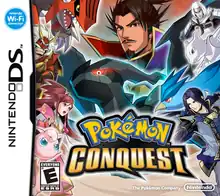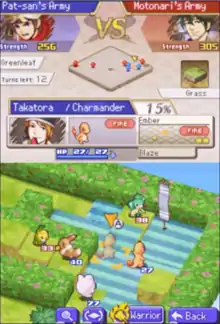Pokémon Conquest
Pokémon Conquest, known in Japan as Pokémon + Nobunaga's Ambition[1] (ポケモン+ノブナガの野望, Pokemon Purasu Nobunaga no Yabō), is a 2012 tactical role-playing video game developed by Tecmo Koei and published by The Pokémon Company and Nintendo for the Nintendo DS. The game is a crossover between the Pokémon and Nobunaga's Ambition video game series. The game was released in Japan on March 17, 2012,[2] in North America on June 18, 2012,[3] and in Europe on July 27, 2012.[4]
| Pokémon Conquest | |
|---|---|
 North American box art | |
| Developer(s) | Tecmo Koei |
| Publisher(s) | |
| Director(s) | Osamu Mieda |
| Producer(s) | Hisashi Koinuma Toshio Miyahara Takato Utsunomiya |
| Designer(s) | Yukinori Ito |
| Programmer(s) | Hideomi Chino |
| Composer(s) | Shinichiro Nakamura |
| Series | Pokémon Nobunaga's Ambition |
| Platform(s) | Nintendo DS |
| Release |
|
| Genre(s) | Tactical role-playing game |
| Mode(s) | Single-player, multiplayer |
Gameplay
The player, accompanied by an Eevee, travels throughout the Ransei Region (ランセ地方, Ranse-chihō) befriending Pokémon and battling Warriors (ブショー, Bushō) and Warlords (ブショーリーダー, Bushō Rīdā) to conquer and unite the region; Warriors and Warlord Leaders can join the player's party once defeated, allowing the player access to more Pokémon. The gameplay is turn-based strategy and is a tactical RPG, unlike the main-series Pokémon games, with different Pokémon capable of using different attacks and means of movement. Warriors and Warlords also have unique battle-changing powers that boost their Pokémon's abilities but may only be used once per battle. These effects range from increased attacking power, health restoration, or even temporary invincibility.

Unlike in the main-series Pokémon games, each Pokémon is capable of using only one move. This move is determined by the Pokémon's species and is usually picked to represent that species; for example, Excadrill uses its signature move Drill Run. Additionally, only 200 of the 649 Pokémon that existed at that time of release are available in the game. The main-series capture system is replaced by a minigame where a Warrior attempts to form a link with a wild Pokémon by coordinating button presses with a display, reminiscent of Dance Dance Revolution. The main-series leveling system is replaced by a concept called "link", a percentage which increases to a certain maximum, and reflects that Pokémon's battling statistics. Each Warrior has a natural affinity to certain types, which grants an increased maximum link with Pokémon of those types. In addition, every Warrior and Warlord has one evolutionary family of Pokémon with which they may form a 100%, or "perfect link" with. In addition, certain Warlords can form links with legendary Pokémon. A Warlord's costume almost always resembles the appearance of at least one of their "perfect link" species. Additionally, the main-series evolution system is changed to reflect the removal of Pokémon levels. Instead of a Pokémon reaching a specific level, they evolve by reaching certain conditions such as reaching a specific link, winning a battle in a specific kingdom or having a stat reach a certain value. Warlords are also able to evolve by reaching certain conditions, such as achieving a certain link percent with a Pokémon. Warlords, other than the player, cannot evolve until after completing the main story.
With few exceptions, the Warriors and Warlords in the game are named after figures in Japanese history,[5] with the game's antagonist Nobunaga (ノブナガ) being a take on the real historical figure Oda Nobunaga. After defeating Nobunaga and completing the main storyline, players can take on 36 special episodes, each featuring one of the other warlords and having different objectives (such as taking over a portion of Ransei rather than the whole region). They feature smarter AI (with the opposing nations attacking your countries more often), the ability to upgrade the locations within the regions through a bank to find more Pokémon or get better items and to evolve the rest of the Warlords. The episodes often reference real historical events, such as Mitsuhide's betrayal of Nobunaga and Hideyoshi's unification of most of Japan. After the episodes of the 16 senior warlords are completed, a final episode will be unlocked, which is essentially a new game with the main playable character but includes the added features of the post-game episodes.
Plot
A legend is foretold that the one who unifies all the 17 kingdoms of the Ransei Region (ランセ地方, Ranse-chihō) will have a chance to encounter the Legendary Pokémon who created the Ransei Region. Warriors and Warlords all over the region sought to fulfill the foretold legend, resulting in battles and an end to Ransei's peaceful era. The game initiates off with the player just becoming the Warlord of the Aurora (ハジメ, Hajime) kingdom and is met by Oichi. Hideyoshi of the nearby kingdom of Ignis (カエン, Kaen) sends his warriors to ambush Aurora, only for them to be defeated by the player and Oichi. Oichi explains to the player that all of the other kingdoms of Ransei had become aggressive and hostile towards one another, in their hopes of fulfilling the Ransei Legend. This initiates the player's harrowing journey of unifying other nations, starting with Ignis, hoping to restore peace upon Ransei. After conquering the kingdoms of Greenleaf (アオバ, Aoba), and Fontaine (イズミ, Izumi), Oichi explains that Nobunaga, who dwells at the northern part of Ransei, is the main threat of the Ransei region. After conquering the kingdoms of Violight (シデン, Shiden), Chrysalia (サナギ, Sanagi), and Pugilis (コブシ, Kobushi), Oichi explains that Nobunaga's ambition is to fulfill the Ransei Legend and use Arceus's power to demolish Ransei.
After conquering the two kingdoms of Terrera (ダイチ, Daichi) and Illusio (ゲンム, Genmu), Oichi hosts a celebration of Shingen and Kenshin's recruitment to the player's army. During the celebration, the player is confronted by Nobunaga, who holds the kingdoms of Avia (ツバサ, Tsubasa), Cragspur (キガン, Kigan), Yaksha (ヤシャ, Yasha), Viperia (ドクガ, Dokuga), Valora (フクシ, Fukushi), Nixtorm (フブキ, Fubuki), and Spectra (ミタマ, Mitama) under his command. Nobunaga informs the player and Oichi of their foolishness of opposing him and returns to his kingdom of Dragnor (リュウ, Ryū). Though his servant Ranmaru pleads with Oichi not to oppose him, Nobunaga states he will annihilate anyone who gets in his way. With Nobunaga and his Zekrom defeated, the player had united Ransei, and the Infinity Tower is revealed. Inside, the player's party finds the Mythical Pokémon Arceus. After linking with Arceus, the player is confronted again with Nobunaga, now partnered with a shiny Rayquaza, along with Mitsuhide, Nō (ノウヒメ, Nouhime), Ieyasu, Ranmaru, and Hideyoshi for a final battle. After being defeated, Nobunaga reveals his true intentions to bring peace to Ransei by destroying Arceus as it is the cause of the conflict. However, seeing the player unaffected by being linked to Arceus, and as the Pokémon takes its leave, Nobunaga relents as Ransei's kingdoms are restored to their proper owners and a system in the region is established.
Development
Pokémon + Nobunaga's Ambition was first revealed at the Shueisha's "Jump Festa" anime and manga event on December 17, 2011. Nintendo and Tecmo Koei announced the game during the event and announced its 2012 release.[2] The Pokémon Company announced a live streaming event that would be used to reveal information to consumers in Japan, and it took place on January 19, 2012.[6] Part of the character designs on the humans also worked on Samurai Warriors 3, with touch-ups from Ken Sugimori. On April 4, 2012, it was announced on Pokemon.com that Pokémon + Nobunaga's Ambition would be released in the United States on June 18, 2012, as Pokémon Conquest.[1]
Reception
| Aggregator | Score |
|---|---|
| Metacritic | 80/100[7] |
| Publication | Score |
|---|---|
| Destructoid | 8/10[8] |
| Famitsu | 34/40[9] |
| Game Informer | 7/10[7] |
| IGN | 9/10[10] |
Pokémon Conquest received positive reviews, possessing a score of 80/100 on Metacritic.[7] Famitsu gave the game a score of 34/40, with reviewers praising the game's accessibility for young players, high replay value, and ability to mix Pokémon with a traditional Japanese historical setting.[9] IGN gave the game a score of 9 and an Editor's Choice award, praising its deep gameplay and calling it "one of the greatest, most fully realized Pokémon spinoffs in existence".[10] Destructoid gave the game 8/10.[8] Game Informer gave the game a 7/10.[7]
The game sold 341,000 copies in Japan in 2012.[11]
In 2012, IGN placed the Pokémon Conquest 12th on their "The Top 25 Nintendo DS Games"[12]
References
- "Pokémon Conquest". Pokemon.com. Archived from the original on 2019-03-03. Retrieved 2012-04-04.
- Sherman, Jennifer (December 16, 2011). "Pokémon + Nobunaga's Ambition Game Revealed". Anime News Network. Archived from the original on February 24, 2014.
- Gilbert, Henry (April 4, 2012). "Pokemon Conquest release date set for DS, is the new name for Nobunaga crossover". GamesRadar. Archived from the original on September 24, 2015. Retrieved June 23, 2012.
- "Pokémon Conquest for Nintendo DS set to launch on 27th July – new features revealed". Nintendo UK. June 27, 2012. Archived from the original on August 11, 2021. Retrieved December 26, 2021.
"Pokémon Conquest voor Nintendo DS verschijnt op 27 juli – nieuwe kenmerken onthuld" (in Dutch). nintendo.nl. June 27, 2012. Archived from the original on April 19, 2021. Retrieved September 25, 2016.
"Pokémon Conquest per Nintendo DS in arrivo il 27 luglio - svelate nuove funzionalità" (in Italian). nintendo.it. June 28, 2012. Archived from the original on April 19, 2021. Retrieved September 25, 2016. - "List of Pokémon Conquest characters - Bulbapedia, the community-driven Pokémon encyclopedia". bulbapedia.bulbagarden.net. Retrieved 2023-08-31.
- "お知らせ|『ポケモン+ノブナガの野望』公式サイト" (in Japanese). Archived from the original on 2022-01-05. Retrieved 2021-10-15.
- "Pokemon Conquest for DS Reviews, Ratings, Credits, and More". Metacritic. 2012-06-19. Archived from the original on 2013-09-04. Retrieved June 18, 2013.
- Sterling, Jim (June 11, 2012). "Review: Pokemon Conquest". Destructoid. Enthusiast Gaming. Archived from the original on December 26, 2021. Retrieved December 26, 2021.
- "Famitsu - review scores | GoNintendo". GoNintendo. 2012-03-27. Archived from the original on 2016-03-04. Retrieved 2012-06-23.
- Drake, Audrey (June 16, 2012). "Pokémon Conquest Review". IGN. Ziff Davis. Archived from the original on December 26, 2021. Retrieved December 26, 2021.
- Sahdev, Ishaan (January 25, 2013). "The Top-30 Best-Selling Games In Japan In 2012 Were..." Siliconera. Enthusiast Gaming. Archived from the original on December 26, 2021. Retrieved December 26, 2021.
- Team, IGN Nintendo (2012-08-08). "The Top 25 Nintendo DS Games". IGN. Retrieved 2022-01-20.
- Attribution
- This article incorporates material derived from the "Pokémon Conquest" article on the koei wiki at Fandom (formerly Wikia) and is licensed under the Creative Commons Attribution-Share Alike License (18 December 2011).
External links
- Official website (in Japanese)
- Official website (US)
- Official website (UK)